Known as "White Man's Boot" - Day 253 - Haiku - for @naturalmedicine's Contest, My Take on Plantain
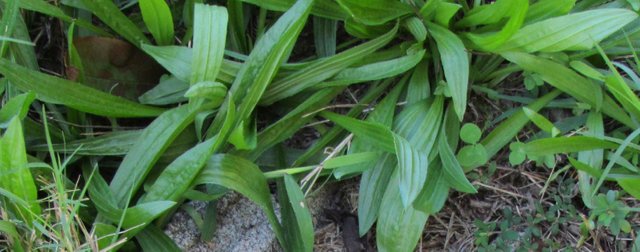

One of the first things our European ancestors brought with them to the New World was their Old World friend plantain, also known as plantago.
A very hardy, perennial herb with heavily veined, fleshy leaves, it was so ubiquitous in the areas where the Europeans traveled and settled that Native Americans began calling it “Englishman’s Foot” or "White Man's Boot," because seemingly everywhere the white man stepped, the plants were sure to follow.
Many theorize that the seeds of plantain, and to a lesser degree of other European plants, were literally carried in the soil in the nooks and crannies of their rarely-cleaned boots.
Then again, according to some, the Latin name roughly translates to "sole of the foot," in reference to the plant's lower leaves growing close and parallel to the ground, so the nickname may have an older origin.

Plantain, a broad-leafed plant with heavily ridged leaves, not to be confused with the tropical green banana-like fruit of the same name, is an incredibly useful herb that has naturalized across the United States, to the point that it has become the bane of many a homeowner, ready to pull out their hair to eradicate it from their lawns.
Not so fast. Pay close attention to the "incredibly useful" part.
There are over two hundred varieties of plantain worldwide, of which two primary species are commonly found nearly everywhere, one of which has narrow leaves, Plantago minor, and the other of which has broader, more rounded leaves, Plantago major. The two plants have very similar properties and are used interchangeably as healing herbs and as food.

The mature leaves tend to be darker green and stringy, so adding them minced finely or blended to green smoothies helps to eliminate the stringiness, or they can be air dried and dehydrated, powdered, and added to soups and other foods for added nutrition.
They can also be chopped finely and added to salads or soups, or steamed, stir-fried or boiled as a potherb for 10 to 15 minutes.
The very young leaves may be used whole, when they are still light green and tender, and added raw to sandwiches and salads.
While older leaves can be a bit hairy and less palatable, they are still useful for food, and my preferred method of using them is to blend them with pure water until they are chopped quite finely, and then add them to soups. I have never found them to turn bitter, unlike many other leafy greens, even after flowering and going to seed.

Another favorite method of is to collect whole, clean leaves after the dew has dried, rinse them and drain in a colander, then rub them with extra virgin olive oil and a little tamari sauce or Bragg’s Liquid Aminos, either of which is similar to soy sauce.
Then dehydrate overnight to make plantain chips, which are delicious, and virtually indistinguishable from kale chips, though they are more tender and less crunchy. This is a great way to prepare and store them for winter use, and can be done with either the broadleaf or the narrow leafed variety.
Plantain is also a preferred food for many animals, wild and domestic, and its seed draws many species of birds to your garden. We keep chickens, ducks, Guinea pigs and rabbits, and they all eat plantain leaves with great relish, preferring it to most other greens.
This is not surprising, as plantain is not only quite tasty, but far more nutritious than nearly any plant food found in the average supermarket, with abundant chlorophyll, phytochemicals and antioxidants, to the extent that it was used as a spring tonic by a number of Native American tribes.

Where plantain really shines, however, is as a healing herb. Native Americans quickly taught the Europeans to use the leaves as poultices over wounds or bug bites, in order to draw out toxins. They commonly did so by binding pulped leaves against the wound, and it was so effective that it gained the nickname “Rattlesnake Weed,” because of its widespread use in treating snake bites.
Native Americans usually chewed the plantain leaves into a pulp before applying and binding them to the wound, making them even more effective than the leaves alone, as saliva carries additional healing properties of its own. Plantain is especially helpful in the case of wounds, Poison Ivy rash, insect bites, minor scrapes or burns.
European healers of the era used the plant in the same ways.
According to Frank Tozer, in his excellent book “The Uses of Wild Plants,” Native Americans also boiled the seeds like rice, added them to soups, or dried and ground them into flour for baking. The seeds are borne on tall spikes, which stand above the plants, making them quite easy to gather. Plantain can produce a prodigious quantity of seed.
Tozer also states that the mucilaginous seed is used medicinally as a bulking laxative, in the same way as psyllium seed, which is harvested from a plant of the same genus. The seed is nutritious and reportedly tasty, so it is good to know that it has enough soluble fiber to be of benefit.

Plantain is a perennial plant, and will come back every year, but it goes in dormant and dies back to the ground in the winter where the ground freezes.
In order to keep it on hand to use its goodness through the winter, my own preferred method is to infuse the chopped plantain leaves in extra virgin olive oil, which is healing in its own right. Although some say to infuse the oil for four to six weeks, I prefer to let it infuse for a period of several months, after which the oil becomes a darker green, and retains even more healing properties of the plantain.
I use Certified Organic Extra Virgin Olive Oil, in an effort to make certain that my infusion will be of the very highest quality, and to make quite certain that the oil is actually 100% pure olive oil, as there are many fraudulent “olive oils” on the market. Only by using Certified Organic oil can you be relatively certain what you are getting.
It is important to make certain that the leaves are completely dry before adding them to the olive oil, which is not to say that the leaves must be dried out completely first, but simply that fresh leaves must be patted dry with no exterior water remaining before chopping for use in the infusion.
Water in the infusion can lead to mold, which is not only unhealthy, but could potentially be dangerous.

Like most herbs used for medicinal purposes, it is best to collect the leaves in the morning after the dew has dried, and to drain and pat dry any stray droplets with clean paper towels or cotton cloths. If in doubt, wait until you can ensure that you are using clean, dry leaves, before making your infusion.
A well-prepared infusion can last for quite a long time at room temperature, and I am just now using the last of an infusion I made in 2012, shortly after moving here. I am writing this on 6 March 2019.
While I strongly recommend making a new infusion every year, for greatest effectiveness, this gives you an idea of how well they can last when prepared and stored properly.
One of my own experiences with plantain infused in olive oil was a couple of years ago, when our dog Lolo evidently strained his foot when jumping around and playing, leaving him with a pronounced limp one evening. I rubbed the plantain-infused oil into his leg, then covered it lightly but securely with a vet's bandage, and by the following morning, there was no sign of a limp. He was completely back to being his usual goofy self.

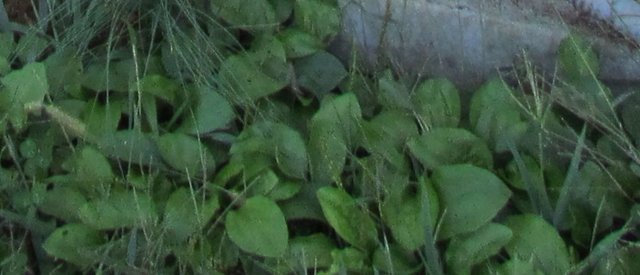

I was lucky upon moving to Tennessee to discover that we have quite a healthy patch of greater plantain literally outside our back door, and much more around the yard, so it has long been one of my go to herbs for pulling and feeding to our rabbits and guinea pigs, along with all its myriad other uses.
Along the way, a few of the many uses I've discovered for the plant, many of which are documented with clinical trials, include helping to quit smoking, supporting the liver and kidneys, supporting healing from various cancers including aiding in detoxifying chemotherapy for colorectal cancer, wound healing, use as a strong antimicrobial and antiviral, and much more. In addition to its use as food, the leaves can be used fresh or dry to make a lovely tea, which is in itself quite healing.
According to an abstract dated 30 Nov 2017:
"The medicinal benefits of Plantago major have been acknowledged around the world for hundreds of years. This plant contains a number of effective chemical constituents including flavonoids, alkaloids, terpenoids, phenolic acid derivatives, iridoid glycosides, fatty acids, polysaccharides and vitamins which contribute to its exerting specific therapeutic effects. Correspondingly, studies have found that Plantago major is effective as a wound healer, as well as an antiulcerative, antidiabetic, antidiarrhoeal, anti-inflammatory, antinociceptive, antibacterial, and antiviral agent. It also combats fatigue and cancer, is an antioxidant and a free radical scavenger. This paper provides a review of the medicinal benefits and chemical constituents of Plantago major published in journals from year 1937 to 2015 which are available from PubMed, ScienceDirect and Google Scholar."
And this is a single abstract: there are many more every bit as compelling.
I strongly recommend getting to know this plant, which is now naturalized all over the world, as it is a compassionate ally in maintaining health and well-being, for ourselves, our pets, friends and family members.
And the new leaves are a welcome quick snack in the early spring to late fall garden. Enjoy!

I am dedicating this post to #naturalmedicine, and in the hopes of furthering this initiative, half the liquid proceeds earned from my post will be awarded to their account.
The photos above were taken by me in early 2012, shortly after moving to our current property in Middle Tennessee. I don't recall which camera I used, but it was likely my Canon SX 30 IS.

#haiku #tribegloballove #tarc #yah #ecotrain #thewritersblock #smg #ghsc #thirtydayhaikuchallenge #teamgood #steemsugars #teamgirlpowa #womenofsteemit #steemusa #qurator #steemitbasicincome #bethechange #chooselove #photography #neighbors #beauty #love #animals #dogs #rescue #adoption #spayandneuter #homesteading #permaculture #naturalhealing #dogrescue #dogsofsteemit #rabbits #animals #grace #poetry #philosophy #beablessing #naturalremedy #gratitude #abundance #give #family #peace #tranquility #giving #donating #philanthropy #naturalhealing #pets #cryptocurrency #culture #peacemaking #peacemaker #friendship, #warmth #self-respect #respect #allowing #plantain #plantago
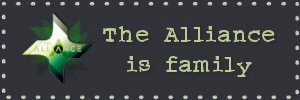
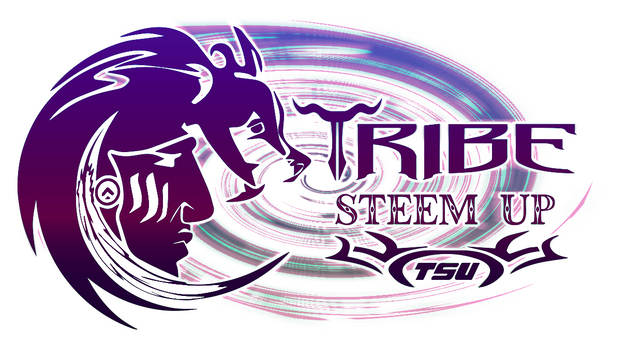




https://steemitimages.com/0x0/https://tinyurl.com/y93h9wt4

art and flair courtesy of @PegasusPhysics

Us On Discord. https://discord.gg/hPJs5Rb



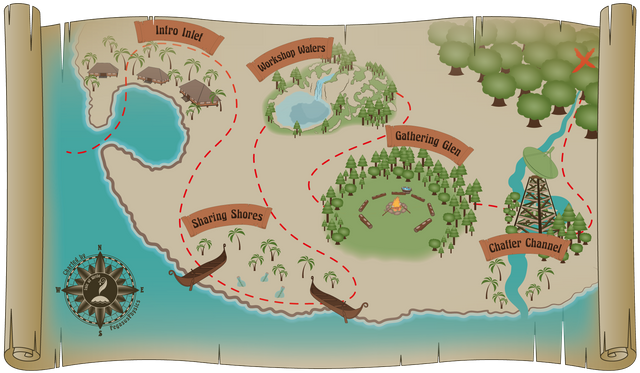
A FABULOUS post... so detailed!! Great to see you have included your own methods for preparing and cooking it too. You are awesome!! That oil sounds fabulous... I'd love to get the greater plantain around here, keeping an eye out!! Xxx Learnt so much reading this!!!
Posted using Partiko Android
I second that!
Wow... I learned a LOT from this post! Plantain is not really known in any of the 3 countries where I have mostly lived. Always appreciating to learn... 🌿
Posted using Partiko Android
Glad to hear it, thanks for your comment!
It always amazes me when people are so anxious to get rid of the "weeds" from their lawns, especially as so often the two most common are dandelion and plantain, both of which are highly nutritious, have lots of different medicinal properties, and can be delicious when properly prepared.
But even when we moved here, though I immediately recognized that plantain was a medicinal herb, I couldn't have told you which one at the time. I had to look it up in my herbal books.
Thank goodness I did. ;-)
Posted using Partiko Android
Congratulations @crescendoofpeace! You have completed the following achievement on the Steem blockchain and have been rewarded with new badge(s) :
Click here to view your Board
If you no longer want to receive notifications, reply to this comment with the word
STOPTo support your work, I also upvoted your post!
Thanks for being a continued advocate of natural medicines on the blockchain! Love your post so much that we’ve also resteemed it.
We welcome new members in our Discord channel, so if you’re reading this and think you’d like to know more about Natural Medicine, please join us here
This post was shared in the Curation Collective Discord community for curators, and upvoted and resteemed by the @c-squared community account after manual review.
@c-squared runs a community witness. Please consider using one of your witness votes on us here
Great information! Being able to harvest fresh springtime greens is the best part about the snow melting and the weather warming up! I loved learning about the history of the plant and it's various names.
Thanks, Melinda, I couldn't agree more. I'm glad you found my post useful!
Posted using Partiko Android
Thank you so much for all this awesome information! This was a lot to ingest, but, I will come back and ingest it little at a time!
Who knew plantains were such an amazing green? Not this chick! Natural Medicine has made such an amazing footprint in our lives now! Thank God for the internet so that we may share information with everyone!
Thank you again!!
!tip
🎁 Hi @crescendoofpeace! You have received 0.1 SBD tip from @dswigle!
@dswigle wrote lately about: If I Could Turn Back Time... Spring Foward! Feel free to follow @dswigle if you like it :)
Sending tips with @tipU - how to guide :)
I've GOT to learn to utilize these plants in my own backyard!
Are you self-taught (books, vs the classroom)? My niece took a one-year class to be an herbalist but during finals week, her mom ended up in the hospital, and my niece has yet to finish the paperwork to get her degree.
This is cool: Native Americans usually chewed the plantain leaves into a pulp before applying and binding them to the wound, making them even more effective than the leaves alone, as saliva carries additional healing properties of its own. Plantain is especially helpful in the case of wounds, Poison Ivy rash, insect bites, minor scrapes or burns.
You are such an incredible wealth of information!
I'm mostly self-taught, @carolkean, though I remember lots of nature walks with my grandmother during camping trips in the Rockies as a kid, and I've gone on several more since moving to Tennessee.
My initial period of deep dive studying about herbs was while I was in Luxembourg, at age 29.
I was there to do legal research, but a couple of times while walking in the woods I pointed out local medicinal plants, so in addition to all the legal casework, the banker I was working for started bringing me book on European herbs in English.
I've amassed a small collection of good herbal books over the years, been given a couple and inherited others, but although I'm an excellent researcher, I still consider myself to be pretty much a neophyte.
And I'm definitely a neophyte when it comes to medicinal and edible mushrooms and fungi. Too many poisonous lookalikes out there. There are only a couple of varieties that I'll bring home without having a mushroom identification book along.
There is just soooo much to know!
Posted using Partiko Android